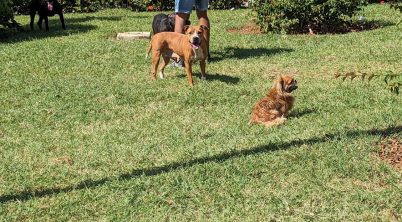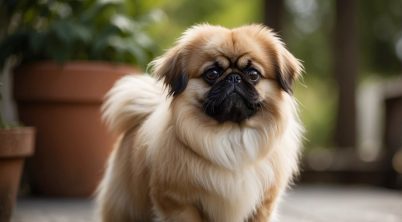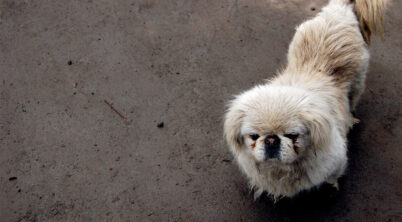The Pekingese and the French bulldog. They don’t exactly look alike, yet they have have quite a number of similarities. Let’s compare the Pekingese dog and the French bulldog based on their history, temperament, characteristics, and many more.
History
Before going into the detailed comparison, let’s discuss the origin of both these dogs. The French Bulldog originated in the 1800’s in Paris, France from the breeding of bulldogs from England and ratters, a type of dog for catching rats and other vermin.
Pekingese are from China in 20 BC. Chinese people bred the Pekingese for centuries to make them companions for the imperial family of China. Now they’re cherished companions, and they meet and greet everyone with grace and dignity.
Temperament
Pekingese dogs are alert, affectionate, courageous, cheerful, curious, friendly, energetic, independent, intelligent, lively, gentle, playful, loving, responsive, quiet, stubborn, social, and loyal. It is a delicate dog and loves to cuddle in your lap. It’s an indoor dog and indeed the best human companion. You do have to train your dog to make him more amiable and obedient.
French bulldogs are alert, cheerful, affectionate, quiet, playful, social, lively, and loyal. They are temperamentally weaker than Pekingese. They are good companion dogs with a powerful, muscular body. They love to relax more than play. The French bulldog is an intelligent dog, and you can easily train him. Moreover, they are not very much obedient.
You can’t leave them alone for a long time because they love to be with humans. They are alert dogs and start barking when a stranger comes. They are apartment-friendly dogs but take them for a 10-15 minute walk. Otherwise, they can gain massive weight. Don’t leave them outside during the hot days.
Care
Pekingese dogs have long, dense, and silky coat. Moreover, the shedding is moderate. They need moderate maintenance. They are difficult to groom. Another critical factor in Pekingese dog’s care is food. The food quantity depends on the size, activity levels, and age of the dog. Food quality dictates the overall health of your dog.
Serve your dog with brown rice, wholesome vegetables, and boiled chicken. Don’t serve spicy foods because they can upset the stomach. Always provide your Pekingese dog with cool and fresh water.
French bulldogs have a short and fine coat. Shedding is minimal. They require low maintenance. Their grooming is relatively easy. Proper nutrition can keep your French bulldog happy and healthy. Use separate food and water bowls for your dog. Don’t feed them uncooked food.
Young French bulldogs require a large amount of food to fulfill the demands of rapidly growing bodies. Buy food from reputable brands. Always feed your dog according to the size, age, and activity levels.
Energy Level
Pekingese dogs have low energy levels. Therefore, they require low exercise. Moreover, their top running speed is 15 mph. Finally, they have low strength.

French bulldogs have low-medium energy levels. Like Pekingese dogs, they also require low exercise. Their top running speed is 12 mph. Moreover, they have low strength.
Appearance and Physical Characteristics
Male Pekingese dogs have a height of 11-18 inches. Female dogs also have the same height. Moreover, male dogs weigh only 3-7 kg, and female French bulldogs have the same weight. The lifespan of Pekingese is 10-15 years. When we compare size, a Pekingese dog is called a toy dog. They’re available in apricot, grey, fawn, cream, and black color.
In contrast, male French bulldogs have 10-14 inches height, and females have 9-13 inches height. Male dogs weigh 9-14 kg, and female dogs only weigh 8-13 kg. French bulldogs only live for 10-12 years. It means they live three years less than Pekingese. It is a medium-sized dog. They’re available in White, Brindle, Tan, Fawn, and Brindle and White. Both these dogs have almost the same litter size.
Family Fit
Both these dog breeds have a friendly nature.
Pekingese dogs are kid-friendly. The good thing is if you’re a new pet owner, these dogs are also pet friendly.
Pekingese dogs want to be loved and cared more than other dog breeds. Treat your dog firmly and kindly, and you’ll feel that it is a caring dog breed.
French bulldogs are not as kid-friendly. Like Pekingese, new pet owners can get these dogs home as well. French bulldogs love to play with children. Ensure that an adult supervises them. They have an exceptional talent for being polite and love chasing. They are easily adaptable, and they don’t like to live alone. They’re sensitive to hot and cold weather, so it’s best to keep them indoors and use an air conditioning system. Furthermore, you can quickly train them.
Barking
Pekingese is a vocal breed and its barking average is high. In contrast, French bulldog barks are none to minimal.
Sleeping Needs
In general, sleeping habits change with age. Pekingese like sleeping and they sleep more. On the other hand, French bulldogs sleep 12-14 hours a day, but they’re not considered a lazy dog breed.
Health Problems
The main health problem for Pekingese dogs is the flat face. It can cause breathing problems. These dogs have large bulging eyes that can lead to issues like cataracts, glaucoma, and eye ulcers. They find it difficult to regulate their body temperature, so they shouldn’t be left outside in hot weather.
French bulldogs can suffer from hair loss. You need to address this issue before it gets worse. Hair loss can become a medical problem when it becomes excessive. Moreover, these dogs can also suffer from a thyroid condition and Von Willebrand’s Decease (VWD). They can also become victims of soft palate due to their flat faces. They have compact airways, so they can’t regulate the temperature effectively as well.
Conclusion
In this article, we have compared Pekingese and French bulldog based on different parameters. Both these dogs are friendly. When it comes to temperament, Pekingese dogs have a slight advantage. Moreover, they live three years more than French bulldogs. Both these dogs are weather-sensitive and require extensive care. Keep an eye on potential health issues so that you can avoid them from getting worse. Overall, both of these dog breeds are family-friendly and great to have at home.
* Banner photo by Jens Mahnke (Free to Use) and Hugo.arg (Some rights reserved) – blended together.









